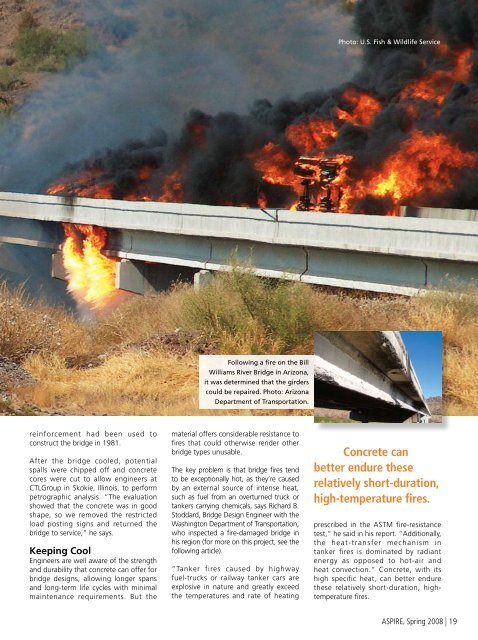ASPIRE Spring 08 - Aspire - The Concrete Bridge Magazine
ASPIRE Spring 08 - Aspire - The Concrete Bridge Magazine
ASPIRE Spring 08 - Aspire - The Concrete Bridge Magazine
You also want an ePaper? Increase the reach of your titles
YUMPU automatically turns print PDFs into web optimized ePapers that Google loves.
Photo: U.S. Fish & Wildlife ServiceFollowing a fire on the BillWilliams River <strong>Bridge</strong> in Arizona,it was determined that the girderscould be repaired. Photo: ArizonaDepartment of Transportation.reinforcement had been used toconstruct the bridge in 1981.After the bridge cooled, potentialspalls were chipped off and concretecores were cut to allow engineers atCTLGroup in Skokie, Illinois, to performpetrographic analysis. “<strong>The</strong> evaluationshowed that the concrete was in goodshape, so we removed the restrictedload posting signs and returned thebridge to service,” he says.Keeping CoolEngineers are well aware of the strengthand durability that concrete can offer forbridge designs, allowing longer spansand long-term life cycles with minimalmaintenance requirements. But thematerial offers considerable resistance tofires that could otherwise render otherbridge types unusable.<strong>The</strong> key problem is that bridge fires tendto be exceptionally hot, as they’re causedby an external source of intense heat,such as fuel from an overturned truck ortankers carrying chemicals, says Richard B.Stoddard, <strong>Bridge</strong> Design Engineer with theWashington Department of Transportation,who inspected a fire-damaged bridge inhis region (for more on this project, see thefollowing article).“Tanker fires caused by highwayfuel-trucks or railway tanker cars areexplosive in nature and greatly exceedthe temperatures and rate of heating<strong>Concrete</strong> canbetter endure theserelatively short-duration,high-temperature fires.prescribed in the ASTM fire-resistancetest,” he said in his report. “Additionally,the heat-transfer mechanism intanker fires is dominated by radiantenergy as opposed to hot-air andheat convection.” <strong>Concrete</strong>, with itshigh specific heat, can better endurethese relatively short-duration, hightemperaturefires.<strong>ASPIRE</strong>, <strong>Spring</strong> 20<strong>08</strong> | 19
















